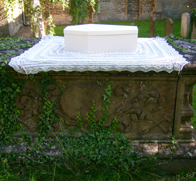
| |
| Home |
| Gallery |
| Exhibitions |
| CV |
| Contact |
| Casket |
The story is based on the baptism, in 1778, of the infant Georgiana - daughter of the third Duke of Chandos. She was baptised by the Archbishop of Canterbury, who pronounced her to be the most docile baby he had ever baptised, her sponsors were no less than King George III and Queen Charlotte. At the time of Georgiana’s death the Burial in Wool Act was still in place, this inspired me to look at Shetland lace christening shawls. Whilst using traditional patterns I have chosen to work in slightly thicker wool and with a denser texture so that the shawl is less airy and has added extra layers of frills to represent the excess of lace that the child was wrapped in. I also looked into burial practices of the period. Recent archaeological investigations at Christ Church, Spitalfields have unearthed coffins from the 18th and 19th centuries. Many of the coffins still show external patterning of decorative nails, which were used to hold in place the fabric that covered the wooden coffin. Old funeral directors account books speak of ‘nail lace’ or ‘coffin lace’, which was originally, the term used for decorative strips of nails rather than, as it later became, lace used to line the inner edge of a coffin. Traditional bobbin lace is worked on prickings, which are made by punching a pattern of holes, with a needle or pin, into parchment or firm card. I have used this technique to mark out a lacy tracery of holes reminiscent of both prickings and the decorative pattern of nails on old coffins. |
